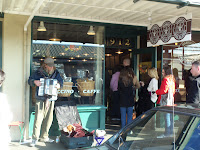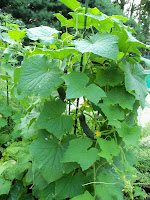 |
| Blue sky, seagull, and rows of vendors |
Last weekend, I visited Seattle, and was drawn to the famous market. Lively, colorful, marvelous and varied, I found so many interesting foods, crafts, people and eating places to explore. This is a history from the website, www.pikeplacemarket.org
"HISTORY OF PIKE PLACE MARKET
"Its nine acres and more than a century of operation encompass thousands of fascinating stories - tales of immigration, internment, renovation and urban renewal - all that help explain why Pike Place Market is called The Soul of Seattle."
 |
| The best looking and tasting salmon! |
"Here is a snapshot of how the Market came to be. Between 1906 and 1907, the cost of onions increased tenfold. Outraged citizens, fed up with paying price-gouging middlemen too much for their produce, found a hero in Seattle City Councilman Thomas Revelle. Revelle proposed a public street market that would connect farmers directly with consumers. Customers would " meet the producer" directly, a philosophy that is still the foundation of all Pike Place Market businesses. On August 17, 1907, Pike Place Market was born. On that first day, a total of eight farmers brought their wagons to the corner of First Avenue and Pike Street, and were quickly overwhelmed by an estimated 10,000 eager shoppers. By 11:00 am, they were sold out. Thousands of would-be customers went home empty handed, but the chaos held promise. By the end of 1907, the first Market building opened with every space filled.
"A century later, Pike Place Market is internationally recognized as America's premier farmers' market and is home to more than 200 year=round commercial businesses; 190 craftspeople and approximately 100 farmers who rent table space by the day; 240 street performers and musicians; and more than 300 apartment units, most of which provide housing for low-income elderly people. "The Market." as the local affectionately say, attracts 10 million visitors a year, making it one of Washington state's most frequently visited destinations."
 |
| The Original Starbucks store |
On Saturday afternoon, I was one of those 10 million and I got an overview of the complexity of the place. There are buildings with indoor booths, and places in the streets for more vendors. Restaurants, musicians, artists were mostly outside. The first Starbucks coffee shop is right there! and people were lined up to enter and grab a Pike Place coffee, or just take photos of the famous birthplace. I had to return on Sunday morning to take a closer look. These two vendors of Jam and Jelly were my favorites.
The first vendor was Canter-Berry farms which was all things blueberry, blueberry jam, syrup, vinegar and chutney. I tasted the vinegar, mellow with a sweet flavor of berries, and the jam was good, too. Doug and Clarissa have been growing blueberries in Auburn WA and making these good preserved for over 25 years. They have the nicest packaging. This is their website, www.blueberries4u.com, where you can order gift baskets online.
 |
| Canter-Berry Farms jam - Pretty! |
 |
| Beware! Six levels of heat! |
The second vendor was Mick's Peppourri. Also family owned and operated since 1982, this company specializes in pepper jellies- unusual varieties with hot peppers paired with fruits, and wine flavors. They offered free samples, too, and I had a few eye'opening experiences with their hot jellies! Their flavors are full and spicy and good. My favorite is the hot pomegranate jelly. There is a website, www.micks.com , and will ship to you with quantity discounts. Then I browsed some booths selling cherries, or honey, or lavender, or pickles, not to mention the lovely seafood vendors.
 |
| Mr. Lee hiding under the hat |
I felt an overwhelming desire to make a jam with this wonderful fruit. But it is November and what fruit is being harvested locally? just pears! apples! I'm told all the berries, tomatoes,etc are shipped up from California. . What is local, what is special? The tables on the street are loaded with vegetables, particularly eye-catching are beautiful multicolored carrots! Easy to carry, hard to bruise and a challenge to make jam from ! yes! I buy the carrots from Lee's Fresh Produce, where Mr Lee tells me about their farms in Redmond, WA, and how they strive to provide local produce free of pesticides and conscious of the community. The produce looks so rich in color and free of spots and holes. I am very impressed. The carrots can probably by transported through the TSA security checkpoints without too much ado. They are innocent, low tech travelers, and I hope to get them home safely.
 |
| My Pike Place natural tote bag |
Here they are in my kitchen. I searched a couple of books and online sources, and there isn’t too much on carrot jam or marmalade, however there are a bunch of interesting takes on carrot cake jam. They sound more accurately like a conserve.
This Recipe is from the Ball Blue Book
 |
| Grated carrots, orange and lemon juice |
4 cups shredded or grated carrots, I used one cup pf purple, one cup of white, two cups of orange carrots
¼ cup lemon juice, ¼ cup orange juice
2 TBS lemon rind grated, 3 cups sugar
1 tsp ground ginger, 1/8 cup or so of water
1 pouch liquid pectin
Note: none of the recipes called for pectin, but I can’t think of making jam without it, the resulting consistency and taste are more like a butter, and might have a scorched flavor.
 |
| A small batch of crunchy carrot jam! |
In a large stockpot, combine the carrots, juices, lemon peel, sugar and water. Bring to a boil, stirring frequently. The carrots will release some liquid, but not too much. Lower the heat to a slow boil and cook for 20 minutes, the carrots did not disintegrate. Add the ginger and bring to a full boil. Add the pectin and boil for 1 minute. Test for jelling and boil another minute if necessary. Turn off the heat, stir well, and fill the jars. Process in water bath canner for 10 minutes for small jars. The texture was crunchy, thick and a medium jell, and the taste was tilted to the lemon side. But a success, spread on a cracker with cream cheese, and good any time and season!

































